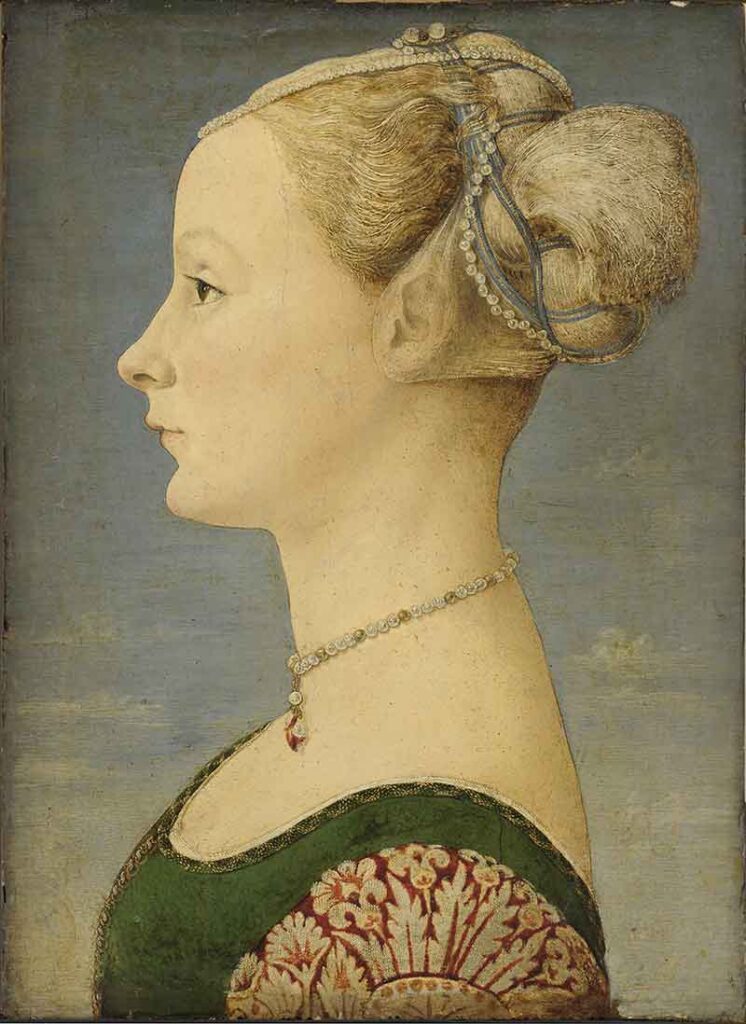Portrait of a Young Woman
Piero del Pollaiolo , ca. 1470
Description

The young woman is depicted against a light blue sky with some clouds. Her face, shown in profile in the tradition of ancient portraiture, is marked by a thin black outline, which makes it stand out. She wears a low-cut bodice laced up in the front. The mass of her hair, supported by a veil, is surrounded by a ribbon and by string of pearls. Two strands of small pearls tied in gold, the “frenello,” descend on her forehead. Her neck is adorned with a necklace with three white pearls alternating with a small gold sphere, to which is attached a pendant with a large ruby.
Great importance is given to the velvet brocade sleeve with a large floral decoration. At that time, dresses had detachable sleeves, secured at the shoulders by ties so that they could be replaced. The sleeves were usually the most valuable part of the dress: some of them were adorned with gems and so were inventoried among the jewels. The richness of the woman’s hairstyle, dress and jewelry suggest that she belonged to the 15th-century Florentine high society.
The jewels have symbolic references to marital love: the white of the pearls evokes purity, the ruby evokes amorous passion. Possibly the portrait was painted close the maiden’s wedding.
In the early 19th century, the painting was in the Milanese palace of Alberico XII Barbiano di Belgioioso d’Este, believed to be a portrait of an ancestor, the wife of Giovanni II Barbiano Count of Cunio. Later, it was in the Borromeo collection, from which Gian Giacomo Poldi Pezzoli acquired it shortly before 1871.
The work, datable to around 1470-1475, belongs to a famous series of female portraits by Piero del Pollaiuolo, now in several European and American museums.
The extraordinary attention paid to the effects of light on the lady’s hair, pearls, and face, shows the influence of the innovations introduced by contemporary Flemish painters.
Data Sheet
Author
Piero del Pollaiolo, 1443-1496
Date
ca. 1470
Material and technique
tempera and oil on panel
Measures
32.7 cm × 45.5 cm
Acquisition
Gian Giacomo Poldi Pezzoli bequest, 1879
Inventory number
0442
location
Golden Room
The Golden Room is the most important room in the Museum and houses the masterpieces of painting from the Poldi Pezzoli collection. Conceived according to the dictates of the Renaissance style, it was designed to be the hall of honor of Gian Giacomo’s apartment. After the collector’s death, Giuseppe Bertini carried on the work: unfortunately, both the gilded coffered ceiling, the frescoes, painted by Bertini himself, and the damask fabric decorations that lined the walls were destroyed by bombing. The current museographic arrangement dates back to the 1990s. Among the works on display are the Portrait of a Lady attributed to Piero del Pollaiolo and which has become a symbol of the museum, Bellini’s Imago Pietatis, Botticelli’s Lamentation over the Dead Christ, Mantegna’s Madonna and Child, and Piero della Francesca’s Saint Nicholas of Tolentino. The display case separating the Salone Dorato from the Sala degli Stucchi houses the porcelain and majolica collections.
collection
Paintings
The Museum hosts over 300 paintings. Among them, many Italian works from the Renaissance: masterpieces from Tuscany (Botticelli, Piero della Francesca, Pollaiuolo), Lombardy (Luini, Boltraffio, Solario) and Veneto (Bellini, Mantegna). Important is also the group of 18th century Italian painting (Guardi, Canaletto, Tiepolo, Fra Galgario). In the collection, there are mainly portraits and small size paintings.
